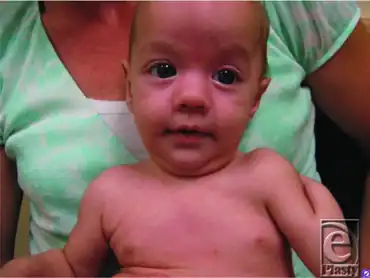Ulnar–mammary syndrome
| Ulnar–mammary syndrome | |
|---|---|
| Other names: Schinzel syndrome | |
 | |
| Facial appearance demonstrating wide forehead, wide nose | |
| Specialty | Dermatology |
Ulnar–mammary syndrome or Schinzel syndrome is a cutaneous condition characterized by nipple and breast hypoplasia or aplasia.[1][2] Features of UMS can be mild to severe and can vary significantly from person to person, even within the same family. The main features of UMS include upper limb defects (including abnormal or incomplete development of the fingers and forearm), underdevelopment of the apocrine and mammary glands (leading to absent breast development and the inability to produce breast milk), and various genital abnormalities. Other signs and symptoms may include hormonal deficiencies, delayed puberty (particularly in males), dental problems and obesity. People with UMS may have distinct facial features, including a wide face tapering to a prominent chin, and a broad nose.[3][4]
Signs and symptoms
The clinical presentation of this condition is the following:[5]
- Uterine abnormalities
- Abnormality of wrist
- Cryptorchidism
- Delayed puberty
- Obesity
- Short stature
Genetics
It has been associated with TBX3.[6] This gene is located on the long arm of chromosome 12 (12q24.21).
Another gene that has been associated with this condition is SYNM.[7] This gene is located on the long arm of chromosome 15 (15q26.3).
Diagnosis
The diagnosis of this condition, Ulnar mammary syndrome is as follows:[6]
- Medical history
- Physical exam
- Laboratory test
- Genetic test
Treatment
The management of this condition is directed toward the specific symptoms of the individual[8]
See also
References
- ↑ Rapini RP, Bolognia JL, Jorizzo JL (2007). Dermatology: 2-Volume Set. St. Louis: Mosby. pp. 896, 7. ISBN 978-1-4160-2999-1.
- ↑ "Schinzel Syndrome". Archived from the original on 2014-08-15. Retrieved 2021-09-19.
- ↑ "Walker-Warburg syndrome | Genetic and Rare Diseases Information Center (GARD) – an NCATS Program". rarediseases.info.nih.gov. Archived from the original on 2018-04-09. Retrieved 2018-04-13.
- ↑ Loyal J, Laub DR (2014). "Ulnar-mammary syndrome: clinical presentation, genetic underpinnings, diagnosis, and treatment". ePlasty. 14: ic35. PMC 4183216. PMID 25328580.
- ↑ "Ulnar-mammary syndrome | Genetic and Rare Diseases Information Center (GARD) – an NCATS Program". rarediseases.info.nih.gov. Archived from the original on 29 August 2017. Retrieved 14 February 2022.
- 1 2 Klopocki E, Neumann LM, Tönnies H, Ropers HH, Mundlos S, Ullmann R (December 2006). "Ulnar-mammary syndrome with dysmorphic facies and mental retardation caused by a novel 1.28 Mb deletion encompassing the TBX3 gene". European Journal of Human Genetics. 14 (12): 1274–9. doi:10.1038/sj.ejhg.5201696. PMID 16896345.
- ↑ Zlotina A, Kiselev A, Sergushichev A, Parmon E, Kostareva A (2018) Rare case of ulnar-mammary-like syndrome With left ventricular tachycardia and lack of TBX3 mutation. Front Genet 9:209
- ↑ "Schinzel Syndrome". NORD (National Organization for Rare Disorders). Archived from the original on 28 January 2022. Retrieved 14 February 2022.
External links
| Classification | |
|---|---|
| External resources |
|